Interview with artists Logan Hunter and Hannah May
Logan Hunter and Hannah May are ceramic artists and educators. Their studio and shop, Hunter & May Pottery, is located just south of Little Rock in Hensley, Arkansas. When not in their home studio, Logan teaches ceramics at Ouachita Baptist University and Hannah teaches ceramics at the Arkansas Regional Innovation Hub. Their vision is a thriving community of ceramics artists who are sharing ideas, resources, and experiences. More of their work can be found at huntermaypotttery.com. (profile photo by Adam Peterson)
AAS: Did both of you grow up in Arkansas? How did the two of you meet?
LH: I was born in Nebraska and my lifelong home is my grandparents’ farm there. I grew up all over including Texas, North Carolina, Arizona, and then eventually landed in Arkansas and attended the University of Arkansas Little Rock, receiving a BA in Studio Art. I met Hannah in the ceramics department while we were both in school. After school, we bought a home together and began renovating a studio. I worked a wide array of jobs which included teaching children’s art lessons in Stuttgart as well as adult drawing lessons at the Arkansas Arts Center Museum School (Arkansas Museum of Fine Art). Currently I teach ceramics as an adjunct at Ouachita Baptist University, Department of Art and Design.
HM: I grew up in Mountain View, Arkansas and moved to Little Rock to attend college at the University of Arkansas Little Rock. After graduating I worked a few contract positions teaching ceramics. Logan’s mom owned a house in Hensley, and she let us turn her garage into a studio, so I spent many hours making pots, mixing clay and glazes, and firing the kiln there so that we could set up to sell at craft shows and online. I also had some part time pottery painting and coffee shop gigs. I learned about the open job at the Innovation Hub thanks to a lunch conversation with some artist friends. The Innovation Hub was in its early phases and did not have art completely integrated yet. I started as the first Lead Art Educator, getting to establish art educational programs for youth and adults and having the opportunity to found a ceramics program that is now one of the Hub’s most attractive features for members. Thankfully, the work Logan and I did to set up our own studio prepared me for working through the challenges of creating a community clay space that people would enjoy using. Logan and I even made work out of that studio primarily from 2017-2019 while we were renovating a building for our current home studio.
AAS: Tell me about Hunter & May Pottery.
LH:/HM: Hunter & May Pottery has been the brand that we have sold our pottery out of and was mostly developed as a way to approach our separate artist businesses as a team effort. We each have different skills to bring, like Logan’s experience with kiln building and building in general and my interests in managing our social presence and business operations. Since buying our own house, we have renovated a large shed on our property for our studio. It was previously an RV cover with an enclosed shop at the back. We rebuilt the staircase, added windows and French doors, replaced the siding, and added insulation and drywall. Outside, we built a lean-to for our kilns. We’ve been using a very small hobby kiln for a couple of years and bought a new electric kiln this year. We are also building a soda kiln.
Organizing our business, website, and taxes comes more naturally to me [HM]. We do most projects and tasks together, but one of us typically is more of the brain and initiator of different tasks. We’ve managed to find ways to create small successes in our home space that we try to share with others through teaching and our artistic practice. However, it’s just as important to focus on failures so that you can always improve.
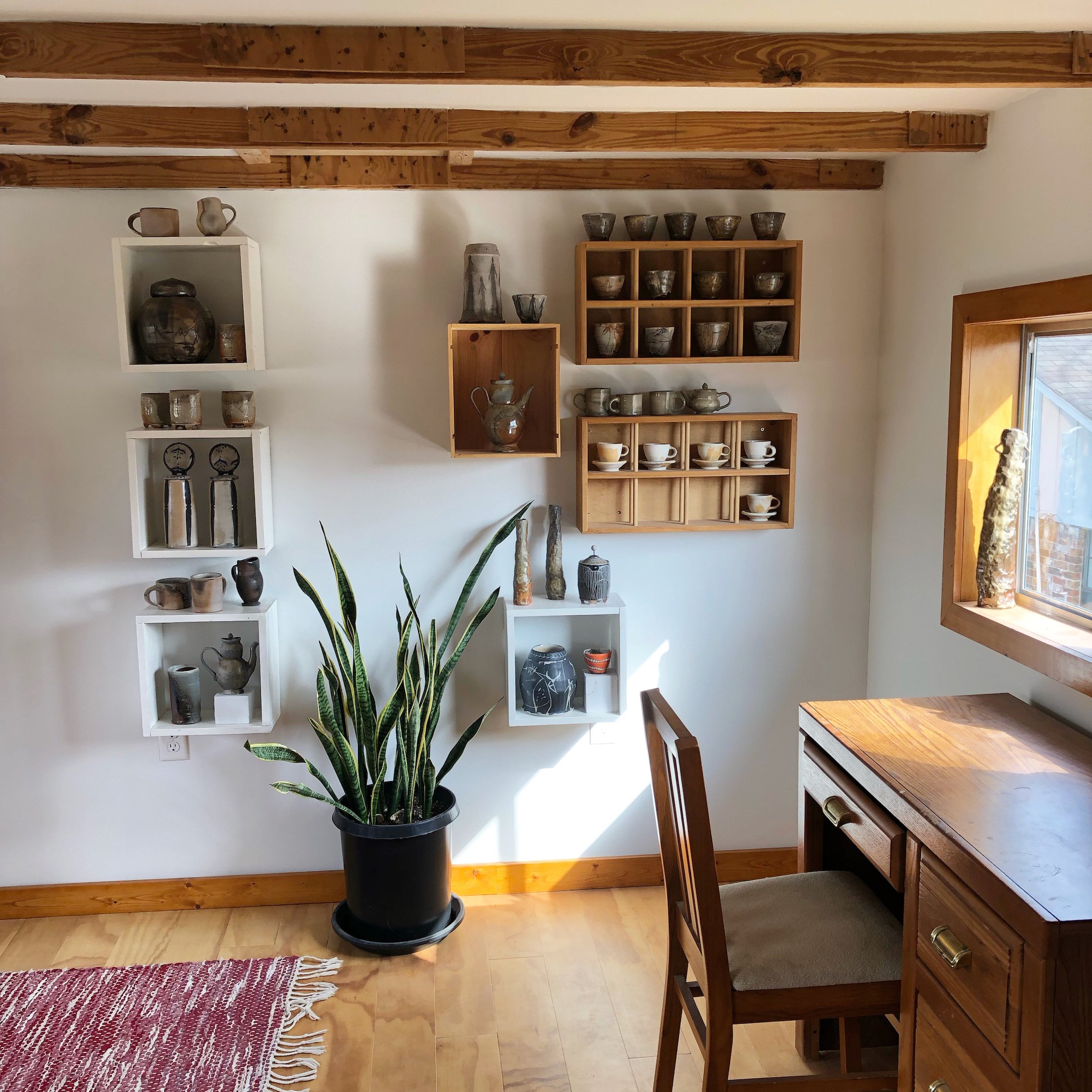
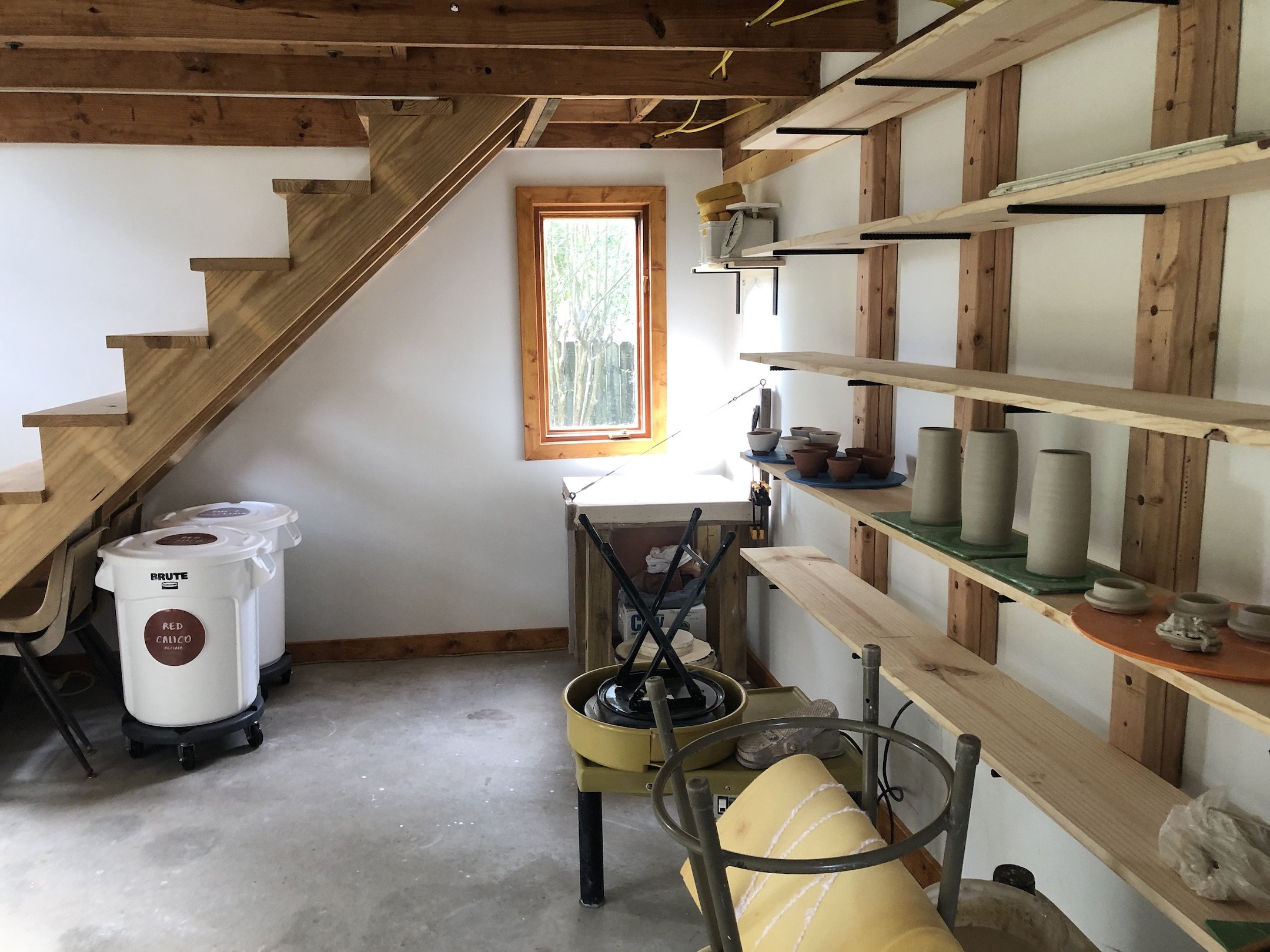
AAS: Both of you teach but teach different types of students, I guess. What do you like most about teaching and what do you think you have learned about yourself and your craft from teaching?
LH: I teach two different courses at OBU. In the fall I teach Ceramics 1, which is set up as a handbuilding course and in the spring, I teach Ceramics 2, which is a beginning wheel throwing class. Since they are both rather entry level courses, I get a pretty solid mix of students. Some are art majors that would possibly teach in the future. However, many are non-art majors that are taking ceramics as an elective and to gain experience.
What I find most rewarding about teaching is getting to help students problem solve. Students bring different ideas with regards to projects. Not every idea is as easy to resolve and often I’m forced to think about technique in slightly different terms than I might have otherwise.
Over time I have found forms and processes that work well to illustrate my own concepts, which are guided by one another. However, when a student brings in an idea for an object that differs from one that I would normally conceive, my standard approach to using a specific construction technique might have to be altered in order to help them achieve success.
This has also led to a lot of personal growth. I know about my materials and how to manipulate them with regards to my own work, but in order to teach I’ve had to solidify my understanding to a degree that enables me to explain it clearly to someone with very little experience. Teaching has been a good tool for illuminating personal weaknesses and an even better motivator for fixing them.
Ceramics studio at the Arkansas Regional Innovation Hub. (photo courtesy of the Hub)
HM: I enjoy sharing ideas and helping people break down complex processes into simple steps. I am most fulfilled in helping someone demystify the steps to getting started on something. That could be a result of my work at the Innovation Hub where accessibility is so important. I don’t want people to stare at a wall thinking about what is on the other side of it. I want to walk them to the door and tell them they can open it and see. I approach teaching just like that. I teach introductory wheel throwing and hand building classes at the Innovation Hub – most are in the form of 2-hour workshops or 2-hour classes that meet once a week for 4 weeks. The goal is either to introduce people to clay through a guided project or to introduce them to the studio and what they need to learn to begin working on their own in the Hub’s clay studio.
I learn best when I get to explore things that I’m excited about and I desire for others to get excited about their own learning without being overly fearful of criticism in the beginning. I allow students to learn from their own mistakes and ask for feedback on their terms. My favorite way to teach is in a mentor/mentee relationship where there is long term inspiration and support provided and teaching by example. I have had a few of these relationships come through my work at the Hub and continue into my home studio. I have also loved coaching students through the process of how to set up a place to work at home if that is their goal. I think I have a lot to offer as a teacher, but my teaching style is not only about knowledge transfer. It’s also about modeling failure and how I resolve issues in my own process and life as an artist and knowing who and how to ask for help.
AAS: Logan, you have a charming set of Settle Cups with some wild carvings or drawings on them. Tell me about that series.
LH: This was a cup set that I created for a friend who had a specific space in mind. He wanted a set of a certain dimension, but otherwise left me to my own decisions. Much of the functional work I create does not typically get titled, but I decided to include these cups in a two person exhibition with Hannah. I displayed them in a way where the images on the cups become the focus. Sort of like a landscape. The title of the work relates to the images on the cups. Each one has a different drawing that in some ways relates to migration or settlement. I use a lot of imagery in my work that references experiences traveling across agrarian landscapes throughout Nebraska, Kansas, and Arkansas.
Settle Cups, 3”h x 30”w x 3”d, ceramic, oxidation fired
AAS: Much of your work is about texture and letting the natural ceramic surface speak through the piece. One of my favorites is Babel. Tell me about that piece.
Babel, 22”h x 13”w x 13”d, ceramic, soda fired
LH: Babel is a piece I made while I was researching a type of firing process called reduction cooling. In a nutshell, this process creates an environment that starves the object of oxygen while it’s cooling in order to get specific color and surface responses from the clay.
It should really be thought of as a drawing in the round. I was thinking about Bruegel’s paintings on the subject and used my hatched abstractions of figures to carve windows in the piece. I don’t mean for this to be thought of as a literal interpretation of the story. Rather it has to do with ambition and how people set goals that they might spend years striving for. Sometimes ambition can distract from the now. It’s really meant to be more of a contemplative than a cautionary.
I don’t like to talk too much about my own interpretations. I do feel that what I bring is important, but so is what the viewer brings. If I talk too much, it can drown out what the piece says on its own.
AAS: I also want to ask you about your drawings. Like your ceramics, they are textural because you let the inherent qualities of the graphite come through. I think a great example of this is Tempus. It is an extraordinary piece. What is the story behind it?
Tempus, 21” x 28”, charcoal and graphite on paper
LH: I made Tempus when my grandparents were both late in their life. My grandad had been crippled from contracting polio when he was just out of high school and as they got older, my grandmother developed severe dementia and her mind had deteriorated pretty badly. Also, we had a fire that didn’t injure anyone but destroyed my mom’s house. So, during this time I was processing a lot of change.
I’m also kind of a science fan and I remember hearing about the term deep time, and how when you look at long enough expanses of time, thousands of years become more like instances in relation. Tempus is kind of an interpretation of that idea. I thought of the entirety of my grandparent’s life and of my life with them and how it could be thought of as a single frame that focuses on this inevitable change. There’s a lot of other compositional narrative I put in, but that’s the overall story - time and change.
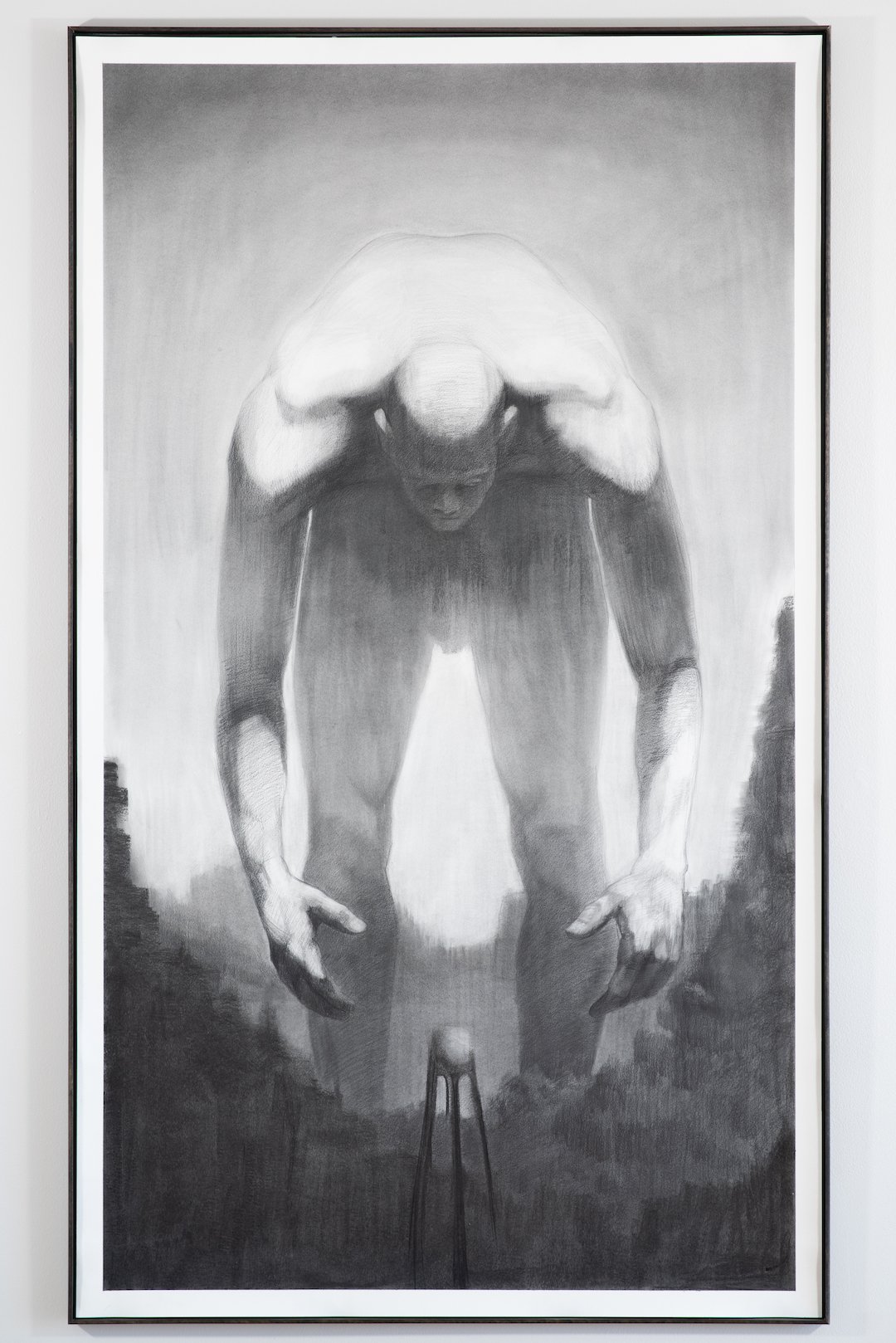

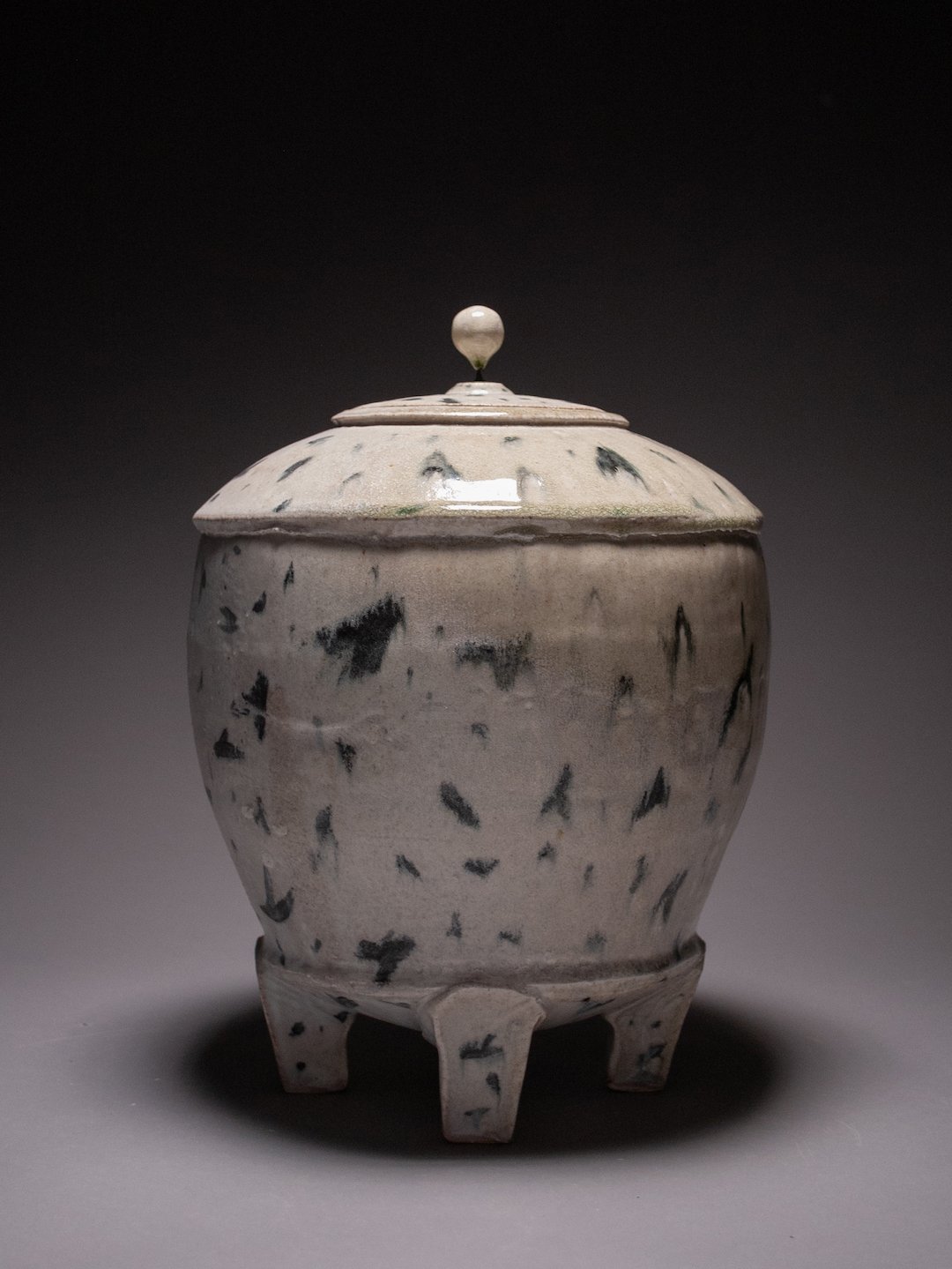
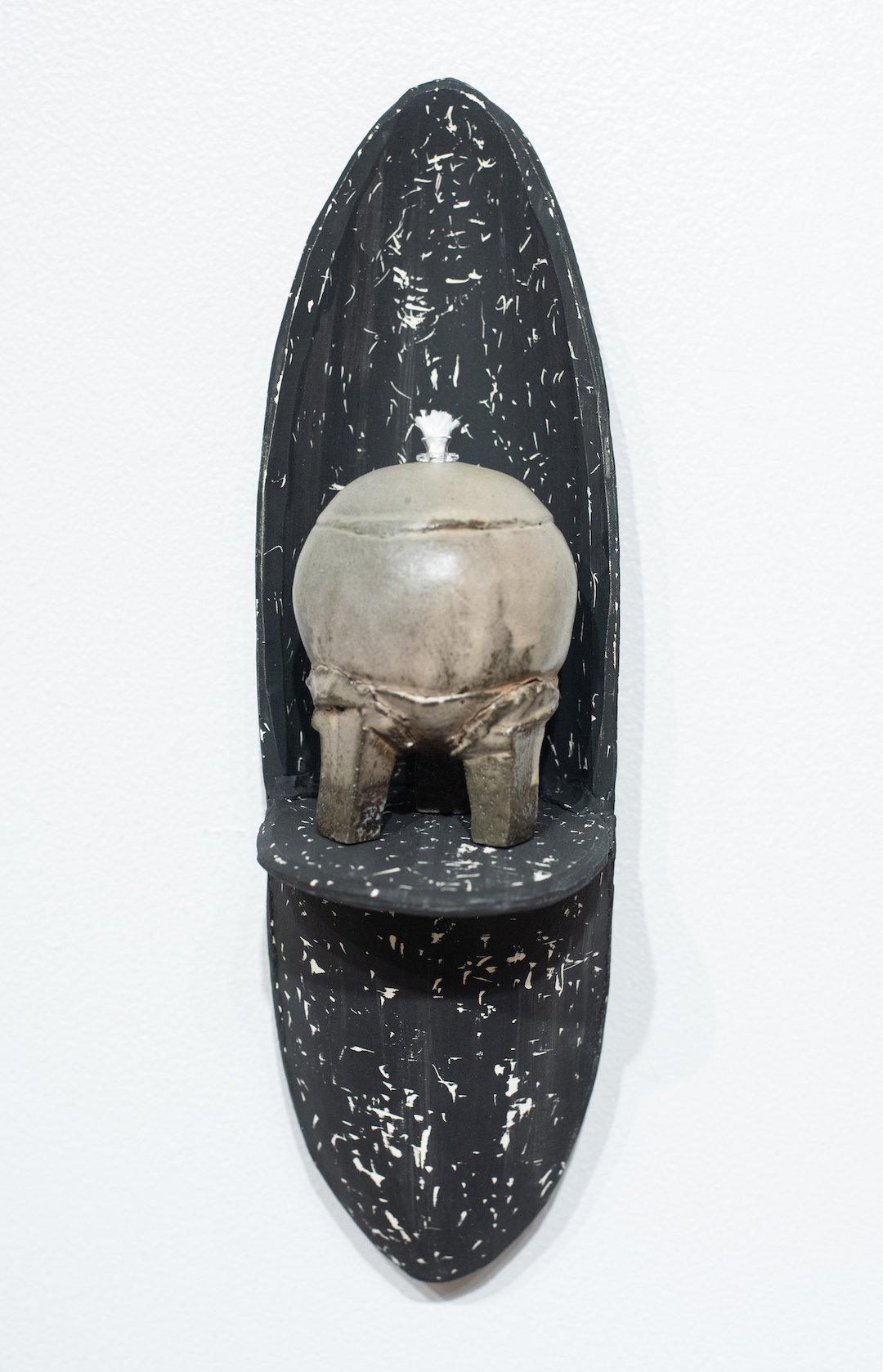
AAS: Hannah, you have a series of vessels under the title Fragments. Your Serving Bowl is just beautiful. Its texture is so well complemented by its surface colorations. How did you achieve that look?
Fragments Serving Bowl, 4.5”h x 5.25”w x 3.75”d, ceramic, soda fired,
HM: The texture of the bowl is a result of the clay body, a high iron body, fired in a reduction soda kiln. The surface colors are underglaze patterns I apply by painting and using cut out shapes that I transfer onto the surface in layers. What I love most about the surface of that bowl is how it came out looking like rusty iron. It’s fitting because one of the ideas behind why I wanted to create the work in the Fragments series was to consider the lifespan of objects and materials. “Fragments” refers to the surface decoration, which features cut out pieces of chairs. I had been thinking a lot about the culture around disposing of furniture and other objects, versus investment in repair. The process of cutting out shapes is a reference to my childhood hobby, scrapbooking, which is a reminder to me of one good reason for deciding to keep objects in my life and pass them along through generations of family. Like photographs, they help us remember and feel connected to people, places, and times.
AAS: Another from that series is Jar. It has a smoother surface. Is that a result of a different firing?
Fragments Jar, 5.25”h x 5.0”w x 5.25”d, stoneware, wood fired
HM: Yes. That jar has been glazed and is wood fired in an anagama kiln. Similar to firing with soda, the atmosphere of the wood kiln can produce areas of blushing and variation of color, as you can see in the piece. The smoother surface is a result of the clay body, which is a white stoneware. This jar has a similar surface decoration to that of the bowl but using slightly different approaches. For the jar, I painted newsprint with black underglaze. Then I cut out pieces and applied them with water to transfer the black from the paper. The bowl was done by painting patches of color on the jar and using the newsprint shapes as stencils over the color patches. I remove the newsprint pieces before firing. These are just two examples, but I have found there are many possibilities for variation within this technique and I plan to continue exploring those for a while.
AAS: Then there is Chair Jar. You’ve done some chair-themed pieces, but this one is so enchanting and makes me think of a Disney character that has come to life. I just love it.
Fragments Chair Jar, 10”h x 6.25”w x 6.25”d, ceramic, oxidation fired
HM: The chair jar on top is a hollow sculpted lid and I can see why it’s giving off Disney character vibes. The bottom is pieces of chairs like in the Fragments series. I hadn’t thought about Disney when making this, but it would be hard to deny the influence it had on my childhood and this piece references some of the same ideas about memory and heirlooms in a more playful way. The flat shapes add a dreamlike–or nightmarish–backdrop to contrast the comfort of the chair cushions. Disney has also retold folk stories from different cultures that have an enchanting tale with a dark side. And actually, I was inspired by a different type of film for this piece. The graphic representation of the tufting as a flat printed pattern rather than sculpted form is inspired by visuals in German expressionist films and used in this piece to reflect how memories can be both comforting but often disconnected from reality or oversimplified. The upholstered part of the chair represents comfort. I have been using chairs as a common theme across a lot of my recent work. I use chairs to symbolize comfort and stability in relation to other life experiences.
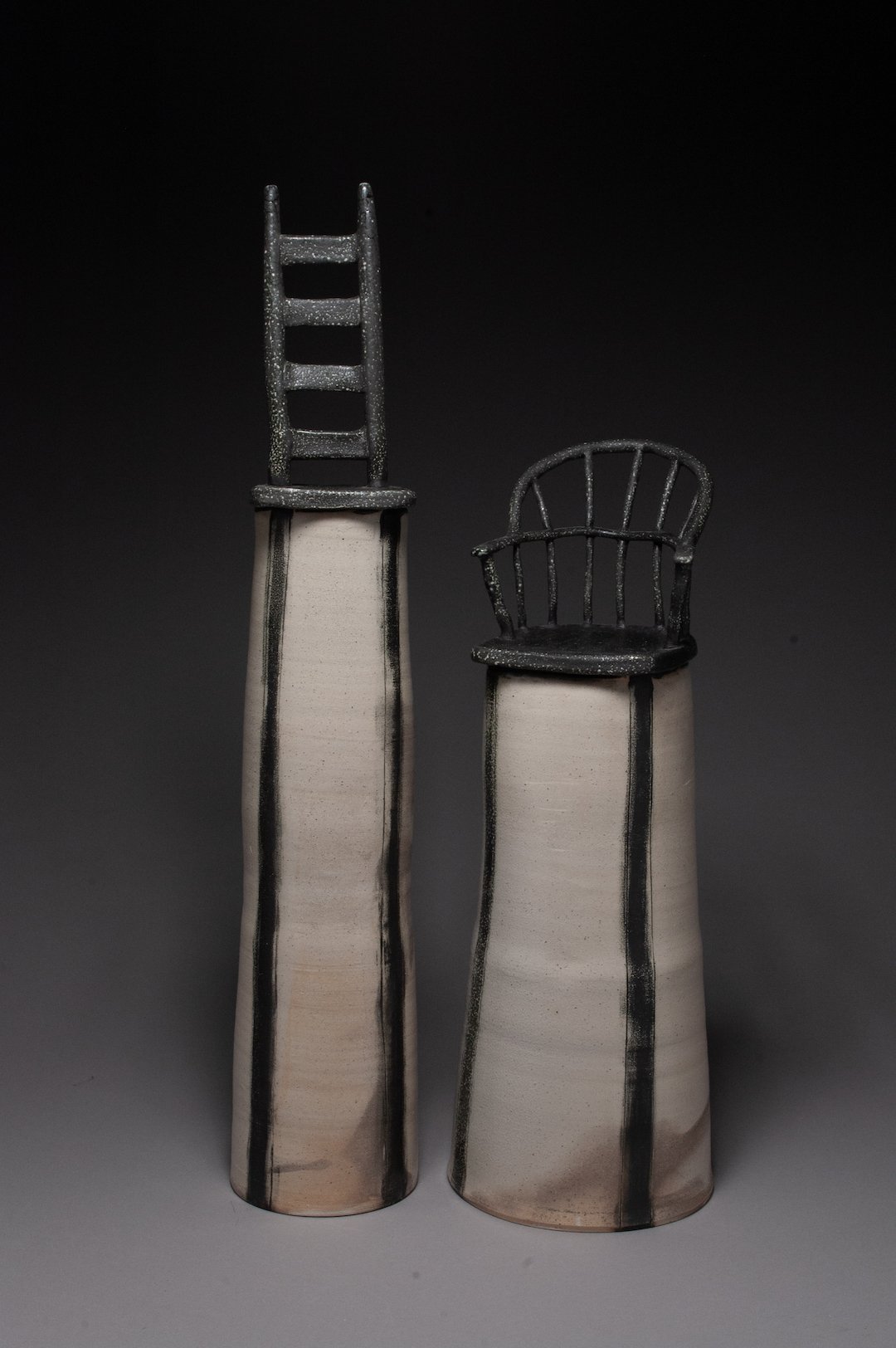
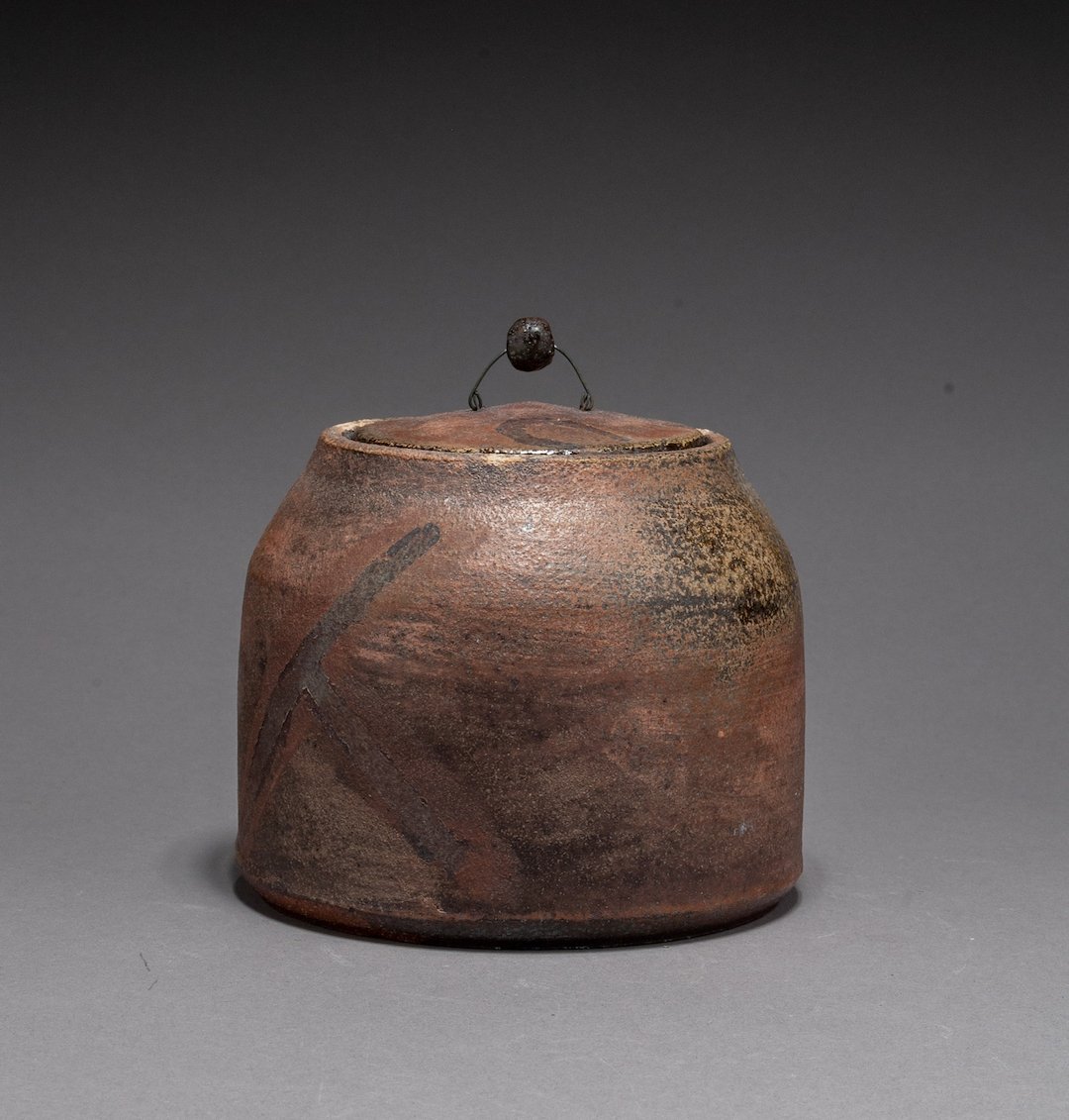
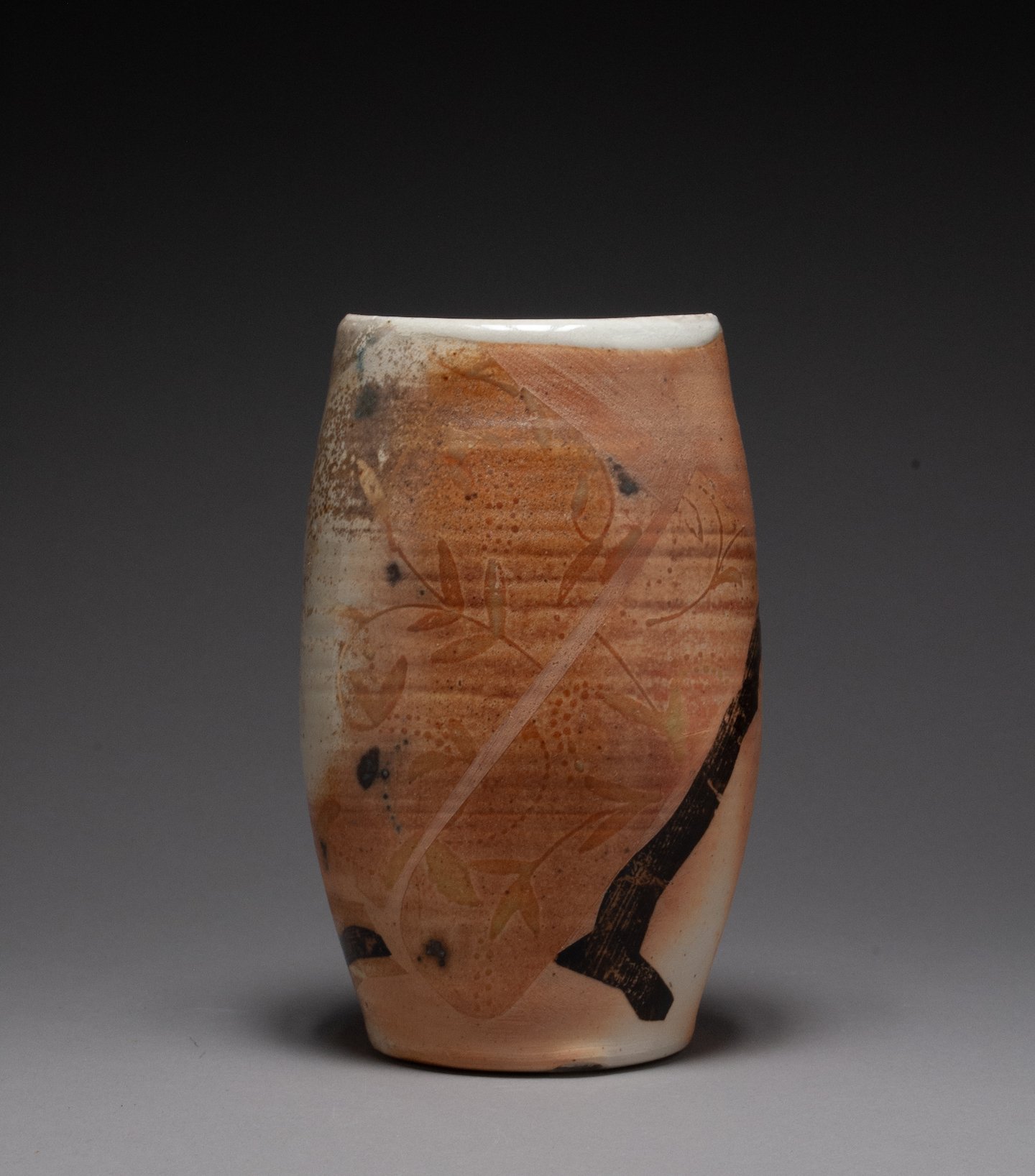

AAS: Tell me more about your studio and gallery. Do you both do all the throwing and firing of your pieces there?
HM/LH: We do all of the throwing and building there as well as electric firing. For atmospheric surfaces, we primarily fire with Stephen Driver in his very large wood kiln near Oark, Arkansas. We have been selling work at the CALS gallery at library square so we will need to find different representation when it closes. We sell at our home by appointment and are creating an online shop through our facebook page. We have also had a holiday sale with Stephen Driver and Louise Halsey at New Deal Studios and Gallery for the past few years.
AAS: There has been a recent addition to the Hunter & May Studio – Winnie. Has she altered in any way the direction either of you will be taking with your practices? What can we expect in the next few years?
HM: I listened to podcasts of interviews with other ceramic artist parents in preparation for Winnie’s arrival. I made a lot of work that I thought I could immediately decorate during my maternity leave from the Hub. My expectations wildly overestimated how much time I would have with free hands. We have to think practically about how we can be productive while she’s awake and how to make the most of time when our hands are free to get clay on them. Clay involves a lot of dust and though we keep our studio relatively clean, clay dries very quickly so anything we touch with it on our hands will become dust. We limit how much we have Winnie in the studio and only one of us can do wet work with her in there. It’s really teaching us to value the limited studio time we can get.
I am excited about some work that will reference my experiences as a new mother. Ironically, I started making bassinets before I knew I was pregnant, and I have a small prototype on my shelves above my workspace. I had also been making reliquaries and houses for miniature objects. They all have a very young girl vibe to them, though they aren’t necessarily about children. I have previously loved when children wanted our pottery and have thought a lot about how important I think it is to expose children to artwork that they enjoy and want to collect. My work is also becoming more about collections and family heirlooms and I have plans to incorporate mark making from Winnie to use as surface layers when she is a more active participant in our studio.
LH: A lot of my work references personal changes in my life and this one is obviously a big one! I’m sure our new addition will produce lots of new work, although as of now most of my ideas are in their infancy (pun intended).


